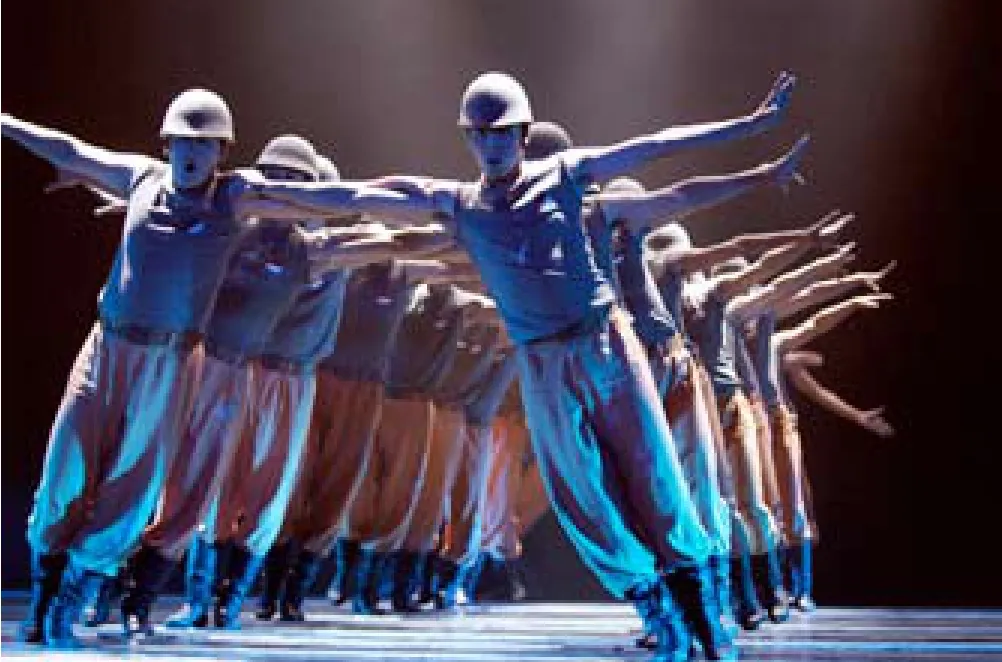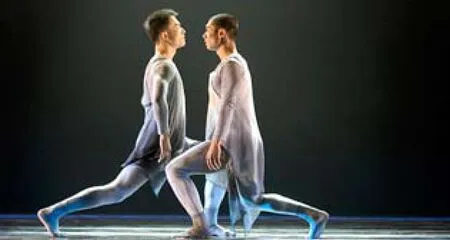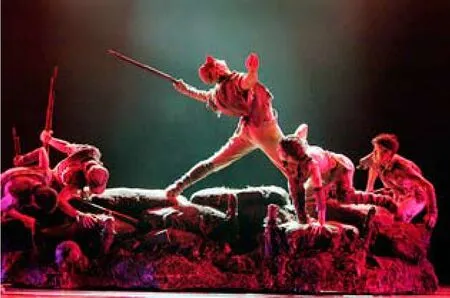Expressiveness in Dance
By ZAN JIFANG
Expressiveness in Dance
By ZAN JIFANG
Chinese modern dance artists seek breakthroughs in their own voice
The Seventh China Lotus Award Modern and Contemporary Dance Competition was held on September 10-15 in Ordos, Inner Mongolia Autonomous Region. It was the second national professional modern and contemporary dance competition in China since 2005, and presented the highest level of contemporary and modern dance while showing the way for the development of the art in China.
Top quality
The event, jointly hosted by the China Federation of Literary and Art Circles(CFLAC) and the Chinese Dancers Association (CDA), attracted approximately 2,000 dancers from 60 professional dance troupes nationwide. A total of 13 modern dance works and 39 contemporary dance works competed for prizes, including best work, best choreography and best presentation.
Compared to previously, many new characteristics emerged in this competition, in terms of creativity, presentation and number of participants, and most of the works paid more attention to and re fl ected the contemporary lives of the Chinese,said Feng Shuangbai, Vice President of the CDA.
For a long time in China, modern dance has been an art with a small audience, which led to low numbers of both modern dance works and dancers. It had been dif fi cult to hold a national modern dance competition because there were so few participants,said Feng. “This year was the fi rst time the CFLAC and the CDA has held a national competition specially for modern and contemporary dance.”
Apart from the high artistic quality of dancers, many dance works in this competition were very impressive because of their experimental, avant-garde ideas in creation and the dancers’ understanding of life, said Feng.
Another new phenomenon was that the competition attracted a wider range of participants, including fl edgling dance companies,freelance choreographers and college students, which showed the recent blossoming of modern dance in China, he said.



Besides, the themes of the dance works,especially of contemporary dance, were more extensive, covering every aspect of life and major social topics. For example,the workRoadmen, which won the gold prize, presented vividly, in dance language,the hardships of road construction workers.Another work,Regretless, which won the silver prize, portrayed a brave young man who lost his life in helping a lady on the road recover a handbag from bandits.
Thinking on modern dance
Regarding modern dance, an art form introduced to China 70 years ago, there were new trends that were worth thinking about, said Luo Bin, Director of the Institute of Dance Studies of the Chinese National Academy of Arts, and a member of the jury of the Ordos competition.
“From these modern dance works, we can see individual spirit has been presented very well. The works reflect free thinking and the desire of choreographers and dancers to express their individual ideas.At the same time, we also saw a variety of presentation methods, which feature either intense con fl ict of inner feelings or humorous choreographic styles,” Luo said.
Solos, duets and trios were the majority of the works in the competition, Luo said.This means modern dance artists are inclining to the development of individuality and creativity.
He also said modern dance works in the competition reflected changes in creative concepts, which might be a sign of the burgeoning of the sinicization of modern dance.
“It might be too early to say it, but I think at least we found many choreographers are exploring on the road of sinicization,” he said. “Because of the great variety of ways of presentation in modern dance, the traditional understanding of people about modern dance is changing. It is a gradual change, very delicate.”
During the competition, audiences could easily fi nd many traditional Chinese cultural and artistic elements in the works,which was very different from the traditional understanding of people of this art. It was also an interesting phenomenon to the jury, Luo said.
“Members of the jury had a heated discussion on following topics: Whether modern dance has lost its core characteristics in China? Whether Chinese modern dance creators have not found a clear direction for future development?” Luo said. “We need to clarify what modern dance should pursue. After all, modern dance is not just an art form, and it embodies people’s concepts and ways of thinking.”
He said currently many modern dance works in China lacked deep thinking or were staying in a state of imitation or repetition, which might be caused by unclear understanding of modern dance.
This, he said, was one of the possibilities of sinicization of modern dance, an inevitable phase of the development of the art form in China.
Another concern, Luo said, was whether modern dance could develop from a less popular art form to one accepted by large numbers of people. “Presently, modern dance is still one of the smallest art circles in China,” he said.




All photos were taken by Ye Jin at the Seventh China Lotus Award Modern and Contemporary Dance Competition in Ordos, Inner Mongolia Autonomous Region
Taking root
Up to now, there have been only six professional modern dance companies in China.Most Chinese have never gone to theaters to watch a modern dance performance. To many people, modern dance equates to a form incomprehensible to audiences.
But, despite the small audience number,modern dance in China has developed very quickly during the past two decades and many excellent dancers and works have won world acclaim.
The earliest systematic and professional teaching and training of modern dance in China started in 1993 when the Department of Choreography of Beijing Dance Academy(BDA) set up a class. Then, modern dance was something new to most Chinese, including the dancers, so foreign masters were invited to the academy to teach.
“After learning from foreign as well as Chinese teachers, we came to a general understanding of modern dance, such as its birth, core skill systems, major schools and the life experiences of modern dance masters like Martha Graham,” said Gao Yanjinzi, one of the fi rst batch of students in the class.
In 1995, the Beijing Modern Dance Company (BMDC) was founded, and the fi rst graduates from the BDA class became the company’s foundation stones.
“In a certain sense, the development of the BMDC can be seen as an epitome of the development process of modern dance in China,” said Gao, Art Director of the dance company, and also a member of the jury of the dance competition in Ordos.
The company had been thinking deeply about what modern dance stood for, Gao said, and it has also been facing the challenge of how to survive, which re fl ected the dif fi culty the form would face before it was widely accepted in China.
“Before I studied modern dance in the BDA, I knew little about the art form,except for the spirit that the dance pursues,which is to dance freely and set yourself as free as you possibly can,” said Gao, who was taught to dance at a very young age by her mother, also a dancer.
“It is natural for me to undertake modern dance, as, since childhood, I could not fi nd a genre or classi fi cation for the type of dance I danced,” she said.
But after graduating from the BDA,Gao spent two months thinking: Why should she dance? What is free dance? If traditional dance is thought to be limited to certain extent, was it true freedom just to learn from several modern dance masters?
After a long time in thought, Gao found her answers: No matter if it was Chinese tradition or foreign masters, they were all nourishing resources ready to serve artists,to help them create something of themselves and express what they want to say.
Based on this kind of in-depth thinking, modern dance entered a blossoming phase in the 1990s in China and greater numbers of Chinese artists have appeared in the world modern dance arena. They have been invited to various art festivals around the world, impressing audiences with their unique ways of expression and their marvelous presentation.
In the future, Gao believes, there will be another boom in modern dance in China and more modern dance groups will emerge.
“Only five or six companies in such a big country is far from suf fi cient to express what people are currently thinking,” she said.“More and more people hope to express their own voice, which is de fi ned by the nature of life, not de fi ned by an art genre.”
The popularity of modern dance in China is not as high as people hoped, but the level of creation of Chinese artists is among the best in the world, Gao said.
She has absolute confidence in saying that, as Chinese choreographers and dancers have been invited to all of the world’s major art festivals, convincing evidence showing the international status of Chinese choreographers or dance groups.
In 1999, Gao won the highest prize,the Grand Prix, at the 12th International Modern Choreography Competition in Belarus for her pieceWorlds.
This made foreigners sit up and take notice of the voice of Chinese choreographers and dancers. Gao herself was later been invited to create new works especially for many important art festivals, such as the prestigious La Biennale di Venezia in Italy, Berlin Art Festival, Singapore Dance Festival and Canada Dance Festival.
Touring overseas and cooperating with foreign artists also helped Gao and her group to stay informed about the latest developments in modern dance in other countries.
But Gao said Chinese modern dance artists often did not have enough time or energy to popularize their work, as most of it goes into creation and rehearsals. Normally,her team spends half of a year performing overseas. At the same time, they must manage to survive. “In this sense, I think popularization needs a more favorable environment, which is not yet well developed in China,” Gao said.
The national dance competition was a good opportunity to popularize modern dance, Gao said. “It advances well the creation of modern dance and provides a chance for artists to exchange and discuss ideas with each other. It’s very helpful for the development of the art form. The biggest value of a competition is that it helps artists to form the proper artistic attitude.”
Modern dance exerts a charm on dancers as they have to ceaselessly explore and think. At the same time it is also attractive to audiences as they did not know before watching the performance what the dance would give to them, Gao said. “It is challenging for both artists and audiences.”
Gao said each of her works was inspired by the state of her life at the time. She believes Chinese culture is deep and rich enough to foster great masters, and the only thing that matters is if an artist is determined enough to march along and explore the road of becoming a master.


